Ortiz de Montellano Paul R.(Ed.) Cytochrome P450. Structure, Mechanism, and Biochemistry
Подождите немного. Документ загружается.

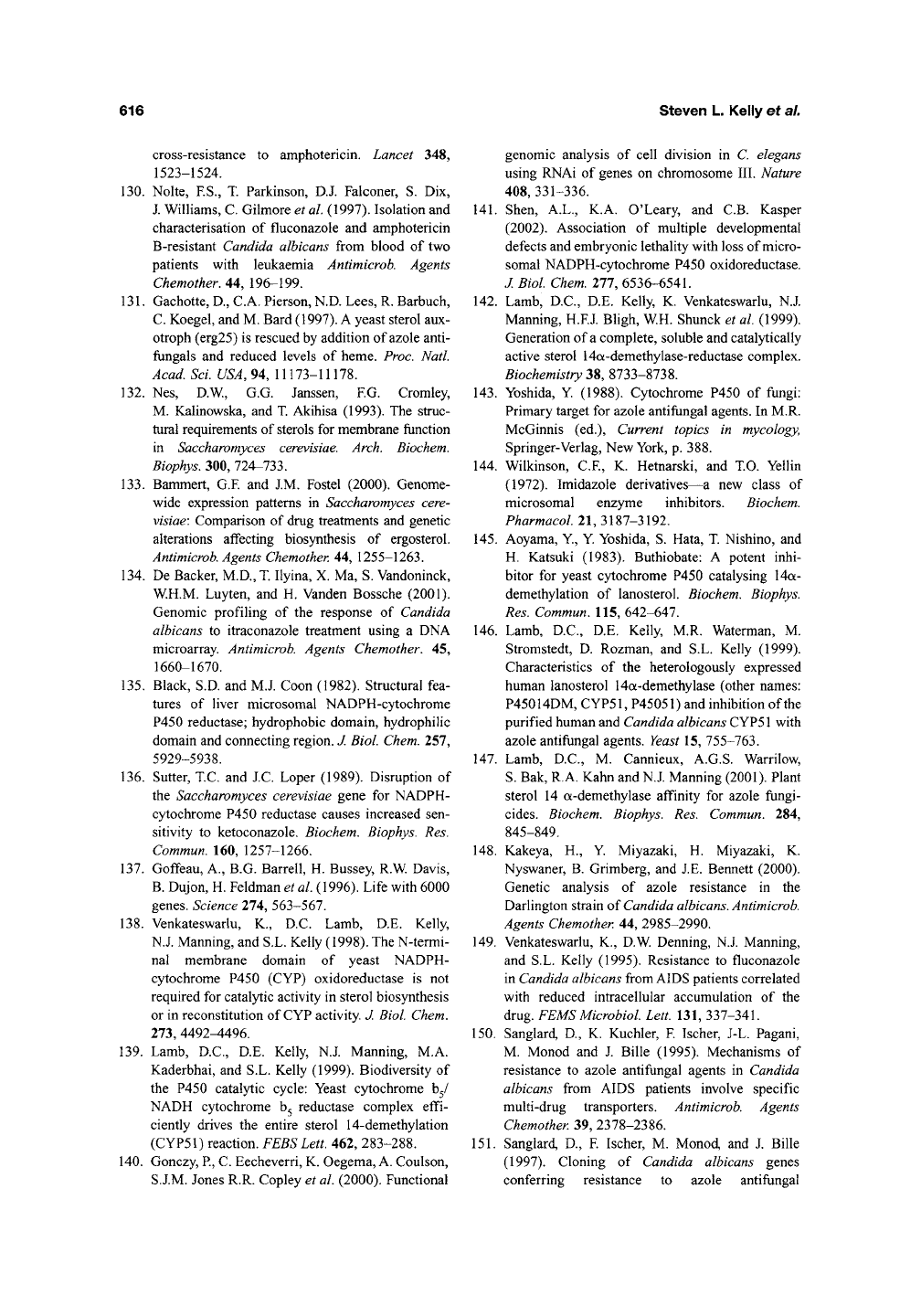
616 Steven L. Kelly et al.
cross-resistance to amphotericin. Lancet 348,
1523-1524.
130.
Nolte, F.S., T. Parkinson, D.J. Falconer, S. Dix,
J. Williams, C. Gilmore et al. (1997). Isolation and
characterisation of fluconazole and amphotericin
B-resistant Candida albicans from blood of two
patients with leukaemia Antimicroh. Agents
Chemother, 44, 196-199.
131.
Gachotte, D., C.A. Pierson,
N.D.
Lees, R. Barbuch,
C. Koegel, and M. Bard (1997). A yeast sterol aux-
otroph (erg25) is rescued by addition of azole anti-
fungals and reduced levels of heme. Proc. Natl.
Acad Sci. USA, 94, 11173-11178.
132.
Nes, D.W., G.G. Janssen, F.G. Cromley,
M. Kalinowska, and T. Akihisa (1993). The struc-
tural requirements of sterols for membrane function
in Saccharomyces cerevisiae. Arch. Biochem.
Biophys. 300, 724-733.
133.
Bammert, G.F and J.M. Fostel (2000). Genome-
wide expression patterns in Saccharomyces cere-
visiae: Comparison of drug treatments and genetic
alterations affecting biosynthesis of ergosterol.
Antimicrob.
Agents Chemother 44, 1255-1263.
134.
De Backer, M.D., T. Ilyina, X. Ma, S. Vandoninck,
W.H.M. Luyten, and H. Vanden Bossche (2001).
Genomic profiling of the response of Candida
albicans to itraconazole treatment using a DNA
microarray. Antimicrob. Agents Chemother. 45,
1660-1670.
135.
Black, S.D. and M.J. Coon (1982). Structural fea-
tures of hver microsomal NADPH-cytochrome
P450 reductase; hydrophobic domain, hydrophilic
domain and connecting region.
J.
Biol. Chem. 257,
5929-5938.
136.
Sutter, T.C. and J.C. Loper (1989). Disruption of
the Saccharomyces cerevisiae gene for NADPH-
cytochrome P450 reductase causes increased sen-
sitivity to ketoconazole. Biochem. Biophys. Res.
Commun. 160, 1257-1266.
137.
Goffeau, A., B.G. Barrell, H. Bussey, R.W. Davis,
B.
Dujon, H. Feldman et al. (1996). Life with 6000
genes.
Science 274, 563-567.
138.
Venkateswarlu, K., DC. Lamb, D.E. Kelly
N.J.
Manning, and S.L. Kelly (1998). The N-termi-
nal membrane domain of yeast NADPH-
cytochrome P450 (CYP) oxidoreductase is not
required for catalytic activity in sterol biosynthesis
or in reconstitution of CYP activity. J. Biol. Chem.
273,
4492^496.
139.
Lamb, D.C., D.E. Kelly, N.J. Manning, M.A.
Kaderbhai, and S.L. Kelly (1999). Biodiversity of
the P450 catalytic cycle: Yeast cytochrome b^/
NADH cytochrome b^ reductase complex effi-
ciently drives the entire sterol 14-demethylation
(CYP51) reaction. FEBS Lett. 462, 283-288.
140.
Gonczy, P., C. Eecheverri, K. Oegema,
A.
Coulson,
S.J.M.
Jones R.R. Copley et al. (2000). Functional
genomic analysis of cell division in C. elegans
using RNAi of genes on chromosome III. Nature
408,331-336.
141.
Shen, A.L., K.A. O'Leary, and C.B. Kasper
(2002).
Association of multiple developmental
defects and embryonic lethality with loss of micro-
somal NADPH-cytochrome P450 oxidoreductase.
J. Biol. Chem. Ill, 6536-6541.
142.
Lamb, DC, D.E. Kelly K. Venkateswarlu, N.J.
Manning, H.F.J. BUgh, W.H. Shunck et al. (1999).
Generation of a complete, soluble and catalytically
active sterol 14a-demethylase-reductase complex.
Biochemistry 38, 8733-8738.
143.
Yoshida, Y. (1988). Cytochrome P450 of fungi:
Primary target for azole antifungal agents. In M.R.
McGinnis (ed.), Current topics in mycology,
Springer-Verlag, New York, p. 388.
144.
Wilkinson, C.F, K. Hetnarski, and TO. Yellin
(1972).
Imidazole derivatives—a new class of
microsomal enzyme inhibitors. Biochem.
Pharmacol. 21, 3\Sl-3\92.
145.
Aoyama, Y, Y Yoshida, S. Hata, T Nishino, and
H. Katsuki (1983). Buthiobate: A potent inhi-
bitor for yeast cytochrome P450 catalysing 14a-
demethylation of lanosterol. Biochem. Biophys.
Res.
Commun. 115, 642-647.
146.
Lamb, DC, DE. Kelly, M.R. Waterman, M.
Stromstedt, D. Rozman, and S.L. Kelly (1999).
Characteristics of the heterologously expressed
human lanosterol 14a-demethylase (other names:
P45014DM,
CYP51,
P45051) and inhibition of the
purified human and Candida albicans
CYP51
with
azole antifungal agents. Yeast 15, 755-763.
147.
Lamb, DC, M. Cannieux, A.G.S. Warrilow,
S. Bak, R.A. Kahn and N.J. Manning (2001). Plant
sterol 14 a-demethylase affinity for azole fungi-
cides.
Biochem. Biophys. Res. Commun. 284,
845-849.
148.
Kakeya, H., Y Miyazaki, H. Miyazaki, K.
Nyswaner, B. Grimberg, and J.E. Bennett (2000).
Genetic analysis of azole resistance in the
Darlington strain of Candida
albicans.
Antimicrob.
Agents Chemother 44, 2985-2990.
149.
Venkateswarlu, K., DW Denning, N.J. Manning,
and S.L. Kelly (1995). Resistance to fluconazole
in Candida albicans from AIDS patients correlated
with reduced intracellular accumulation of the
drug. FEMS Microbiol. Lett. 131,
337-341.
150.
Sanglard, D, K. Kuchler, F. Ischer, J-L. Pagani,
M. Monod and J. Bille (1995). Mechanisms of
resistance to azole antifungal agents in Candida
albicans from AIDS patients involve specific
multi-drug transporters. Antimicrob. Agents
Chemother 39, 2378-2386.
151.
Sanglard, D., F. Ischer, M. Monod, and J. Bille
(1997).
Cloning of Candida albicans genes
conferring resistance to azole antifungal
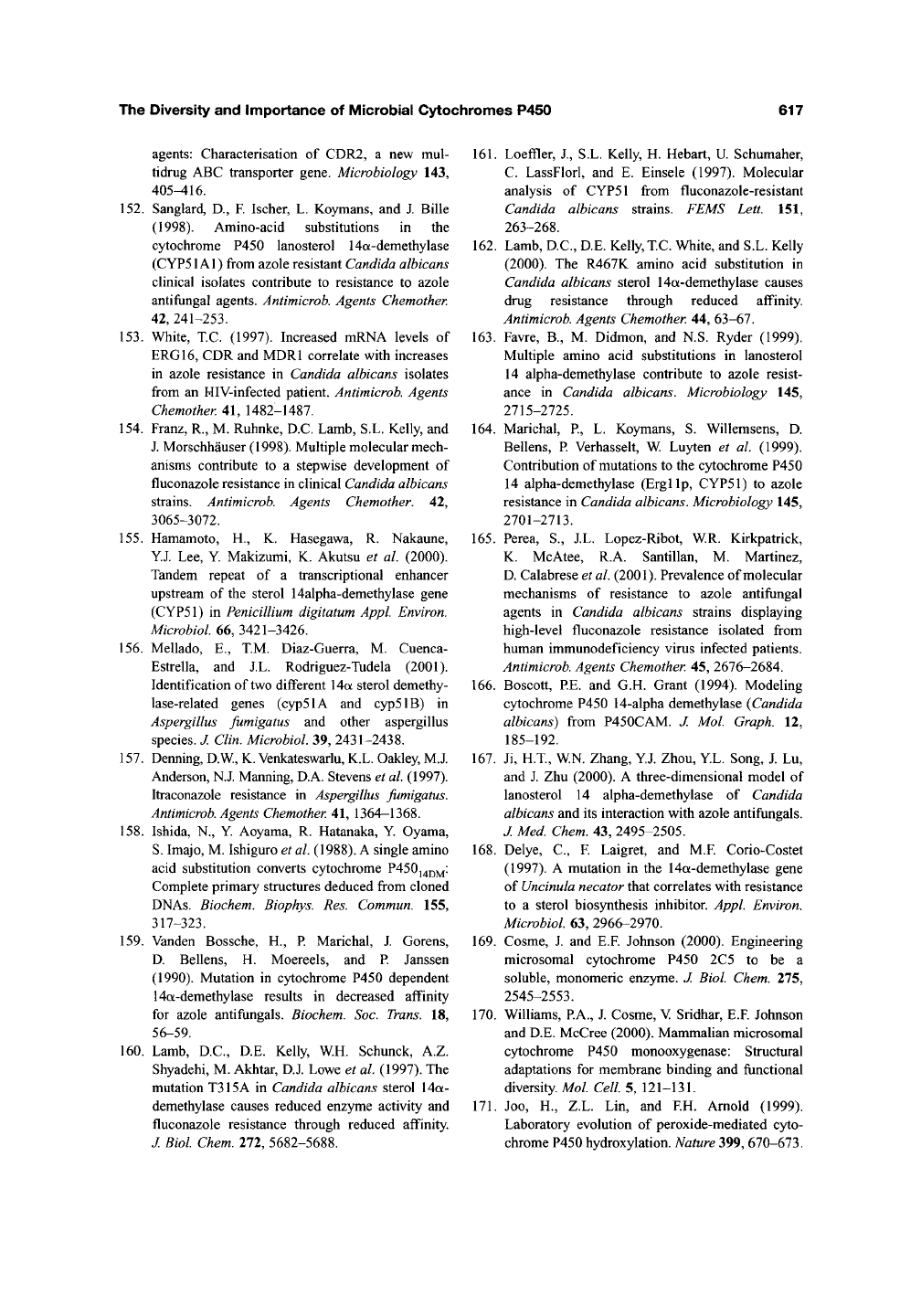
The Diversity and importance of iVIicrobial Cytociiromes P450 617
agents: Characterisation of CDR2, a new mul-
tidrug ABC transporter gene. Microbiology 143,
405-416.
152.
Sanglard, D., F. Ischer, L. Koymans, and J. Bille
(1998).
Amino-acid substitutions in the
cytochrome P450 lanosterol 14a-demethylase
(CYP51A1) from azole resistant Candida albicans
clinical isolates contribute to resistance to azole
antifungal agents. Antimicrob. Agents Chemother.
42,
241-253.
153.
White, T.C. (1997). Increased mRNA levels of
ERG
16,
CDR and MDRl correlate with increases
in azole resistance in Candida albicans isolates
from an HIV-infected patient. Antimicrob, Agents
Chemother 41, 1482-1487.
154.
Franz, R., M. Ruhnke, D.C. Lamb, S.L. Kelly, and
J. Morschhauser (1998). Multiple molecular mech-
anisms contribute to a stepwise development of
fluconazole resistance in clinical Candida albicans
strains. Antimicrob. Agents Chemother. 42,
3065-3072.
155.
Hamamoto, H., K. Hasegawa, R. Nakaune,
Y.J. Lee, Y. Makizumi, K. Akutsu et al. (2000).
Tandem repeat of a transcriptional enhancer
upstream of the sterol 14alpha-demethylase gene
(CYP51) in Penicillium digitatum Appl. Environ.
Microbiol. 66, 3421-3426.
156.
Mellado, E., T.M. Diaz-Guerra, M. Cuenca-
Estrella, and J.L. Rodriguez-Tudela (2001).
Identification of two different 14a sterol demethy-
lase-related genes (cyp51A and cyp51B) in
Aspergillus fumigatus and other aspergillus
species. J. Clin. Microbiol. 39, 2431-2438.
157.
Denning, D.W., K. Venkateswarlu, K.L. Oakley, M.J.
Anderson, N.J. Manning, D.A. Stevens et
al.
(1997).
Itraconazole resistance in Aspergillus fumigatus.
Antimicrob.
Agents Chemother 41, 1364-1368.
158.
Ishida, N., Y Aoyama, R. Hatanaka, Y. Oyama,
S. Imajo, M. Ishiguro et al. (1988). A single amino
acid substitution converts cytochrome P450j4pj^:
Complete primary structures deduced from cloned
DNAs. Biochem. Biophys. Res. Commun. 155,
317-323.
159.
Vanden Bossche, H., P. Marichal, J. Gorens,
D.
Bellens, H. Moereels, and P. Janssen
(1990).
Mutation in cytochrome P450 dependent
14a-demethylase results in decreased affinity
for azole antifungals. Biochem. Soc. Trans. 18,
56-59.
160.
Lamb, D.C, D.E. Kelly, W.H. Schunck, A.Z.
Shyadehi, M. Akhtar, D.J. Lowe et al (1997). The
mutation T315A in Candida albicans sterol 14a-
demethylase causes reduced enzyme activity and
fluconazole resistance through reduced affinity.
J. Biol. Chem. 212, 5682-5688.
161.
Loeffler, J., S.L. Kelly, H. Hebart, U. Schumaher,
C. LassFlorl, and E. Einsele (1997). Molecular
analysis of CYP51 from fluconazole-resistant
Candida albicans strains. FEMS Lett. 151,
263-268.
162.
Lamb, DC, D.E. Kelly, TC White, and S.L. Kelly
(2000).
The R467K amino acid substitution in
Candida albicans sterol 14a-demethylase causes
drug resistance through reduced affinity.
Antimicrob. Agents Chemother 44, 63-67.
163.
Favre, B., M. Didmon, and N.S. Ryder (1999).
Multiple amino acid substitutions in lanosterol
14 alpha-demethylase contribute to azole resist-
ance in Candida albicans. Microbiology 145,
2715-2725.
164.
Marichal, P., L. Koymans, S. Willemsens, D.
Bellens, R Verhasselt, W. Luyten et al. (1999).
Contribution of mutations to the cytochrome P450
14 alpha-demethylase (Erglip, CYP51) to azole
resistance in Candida albicans. Microbiology 145,
2701-2713.
165.
Perea, S., J.L. Lopez-Ribot, WR. Kirkpatrick,
K. McAtee, R.A. Santillan, M. Martinez,
D.
Calabrese
etal.
(2001). Prevalence of molecular
mechanisms of resistance to azole antifungal
agents in Candida albicans strains displaying
high-level fluconazole resistance isolated from
human immunodeficiency virus infected patients.
Antimicrob. Agents Chemother 45, 2676-2684.
166.
Boscott, RE. and G.H. Grant (1994). Modeling
cytochrome P450 14-alpha demethylase {Candida
albicans) from P450CAM. J. Mol. Graph. 12,
185-192.
167.
Ji, H.T, W.N. Zhang, YJ. Zhou, YL. Song, J. Lu,
and J. Zhu (2000). A three-dimensional model of
lanosterol 14 alpha-demethylase of Candida
albicans and its interaction with azole antifungals.
J. Med Chem. 43, 2495-2505.
168.
Delye, C, F Laigret, and M.F. Corio-Costet
(1997).
A mutation in the 14a-demethylase gene
of Uncinula necator that correlates with resistance
to a sterol biosynthesis inhibitor. Appl. Environ.
Microbiol. 63, 2966-2970.
169.
Cosme, J. and E.F. Johnson (2000). Engineering
microsomal cytochrome P450 2C5 to be a
soluble, monomeric enzyme. J. Biol. Chem. 275,
2545-2553.
170.
Williams, RA., J. Cosme, V Sridhar, E.R Johnson
and D.E. McCree (2000). Mammalian microsomal
C3^ochrome P450 monooxygenase: Structural
adaptations for membrane binding and functional
diversity. Mol Cell 5,
121-131.
171.
Joo, H., Z.L. Lin, and EH. Arnold (1999).
Laboratory evolution of peroxide-mediated cyto-
chrome P450 hydroxylation. Nature 399, 670-673.
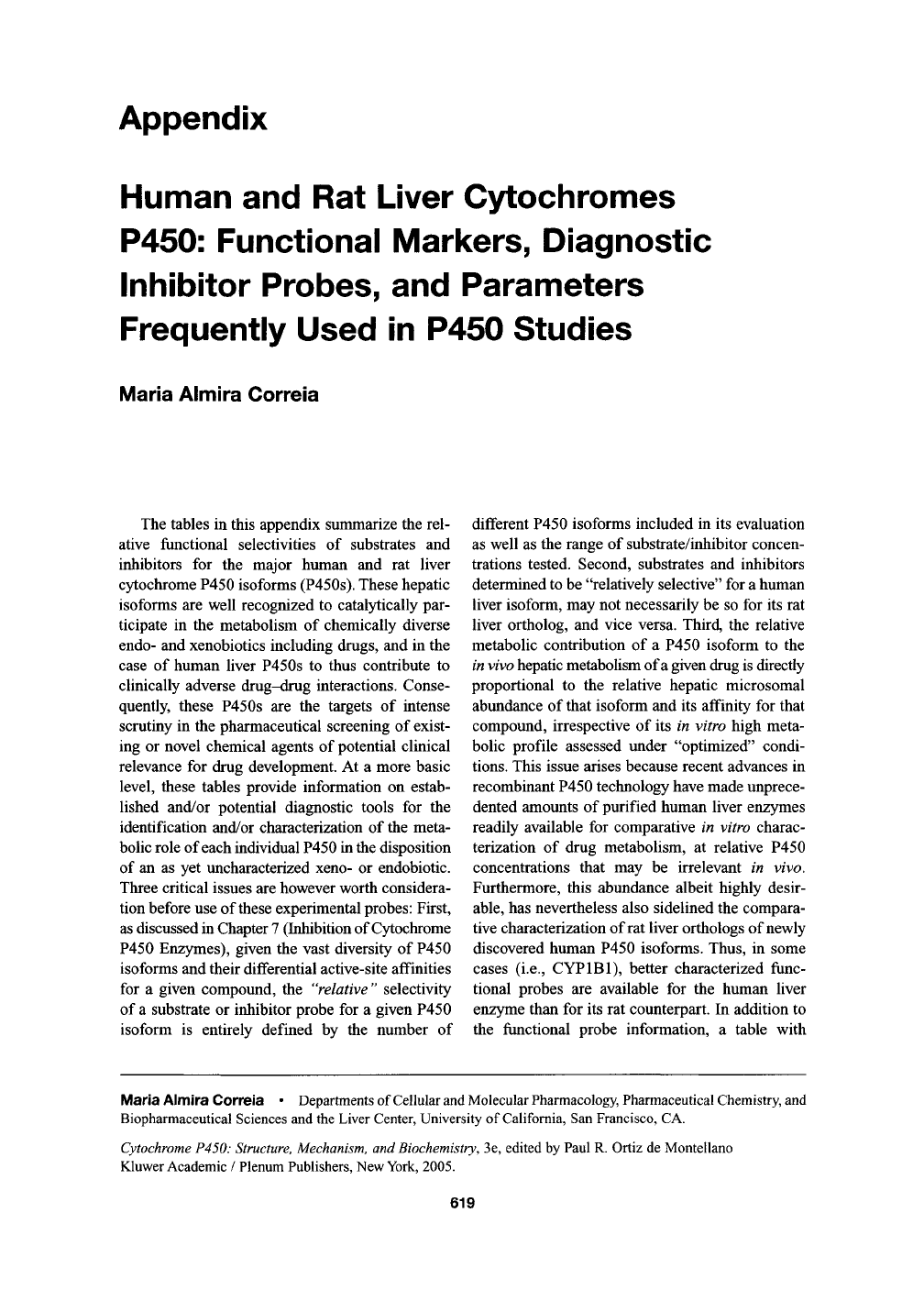
Appendix
Human and Rat Liver Cytochromes
P450:
Functional Markers, Diagnostic
Inhibitor Probes, and Parameters
Frequently Used in P450 Studies
Maria Almira Correia
The tables in this appendix summarize the rel-
ative functional selectivities of substrates and
inhibitors for the major human and rat liver
C3^ochrome P450 isoforms (P450s). These hepatic
isoforms are well recognized to catalytically par-
ticipate in the metabolism of chemically diverse
endo-
and xenobiotics including drugs, and in the
case of human liver P450s to thus contribute to
clinically adverse drug-drug interactions. Conse-
quently, these P450s are the targets of intense
scrutiny in the pharmaceutical screening of exist-
ing or novel chemical agents of potential clinical
relevance for drug development. At a more basic
level, these tables provide information on estab-
lished and/or potential diagnostic tools for the
identification and/or characterization of the meta-
bolic role of each individual P450 in the disposition
of an as yet uncharacterized xeno- or endobiotic.
Three critical issues are however worth considera-
tion before use of these experimental probes: First,
as discussed in Chapter
7
(Inhibition of Cytochrome
P450 Enzymes), given the vast diversity of P450
isoforms and their differential active-site affinities
for a given compound, the "relative" selectivity
of a substrate or inhibitor probe for a given P450
isoform is entirely defined by the number of
different P450 isoforms included in its evaluation
as well as the range of substrate/inhibitor concen-
trations tested. Second, substrates and inhibitors
determined to be "relatively selective" for a human
liver isoform, may not necessarily be so for its rat
liver ortholog, and vice versa. Third, the relative
metabolic contribution of a P450 isoform to the
in vivo
hepatic metabolism of a given drug is directly
proportional to the relative hepatic microsomal
abundance of that isoform and its affinity for that
compound, irrespective of its in vitro high meta-
bolic profile assessed under "optimized" condi-
tions.
This issue arises because recent advances in
recombinant P450 technology have made unprece-
dented amounts of purified human liver enzymes
readily available for comparative in vitro charac-
terization of drug metabolism, at relative P450
concentrations that may be irrelevant in vivo.
Furthermore, this abundance albeit highly desir-
able,
has nevertheless also sidelined the compara-
tive characterization of rat liver orthologs of newly
discovered human P450 isoforms. Thus, in some
cases (i.e., CYPIBI), better characterized func-
tional probes are available for the human liver
enzyme than for its rat counterpart. In addition to
the functional probe information, a table with
Maria Almira Correia • Departments of Cellular and Molecular Pharmacology, Pharmaceutical Chemistry, and
Biopharmaceutical Sciences and the Liver Center, University of California, San Francisco, CA.
Cytochrome P450: Structure, Mechanism, and Biochemistry, 3e, edited by Paul R. Ortiz de Montellano
Kluwer Academic / Plenum Publishers, New
York,
2005.
619
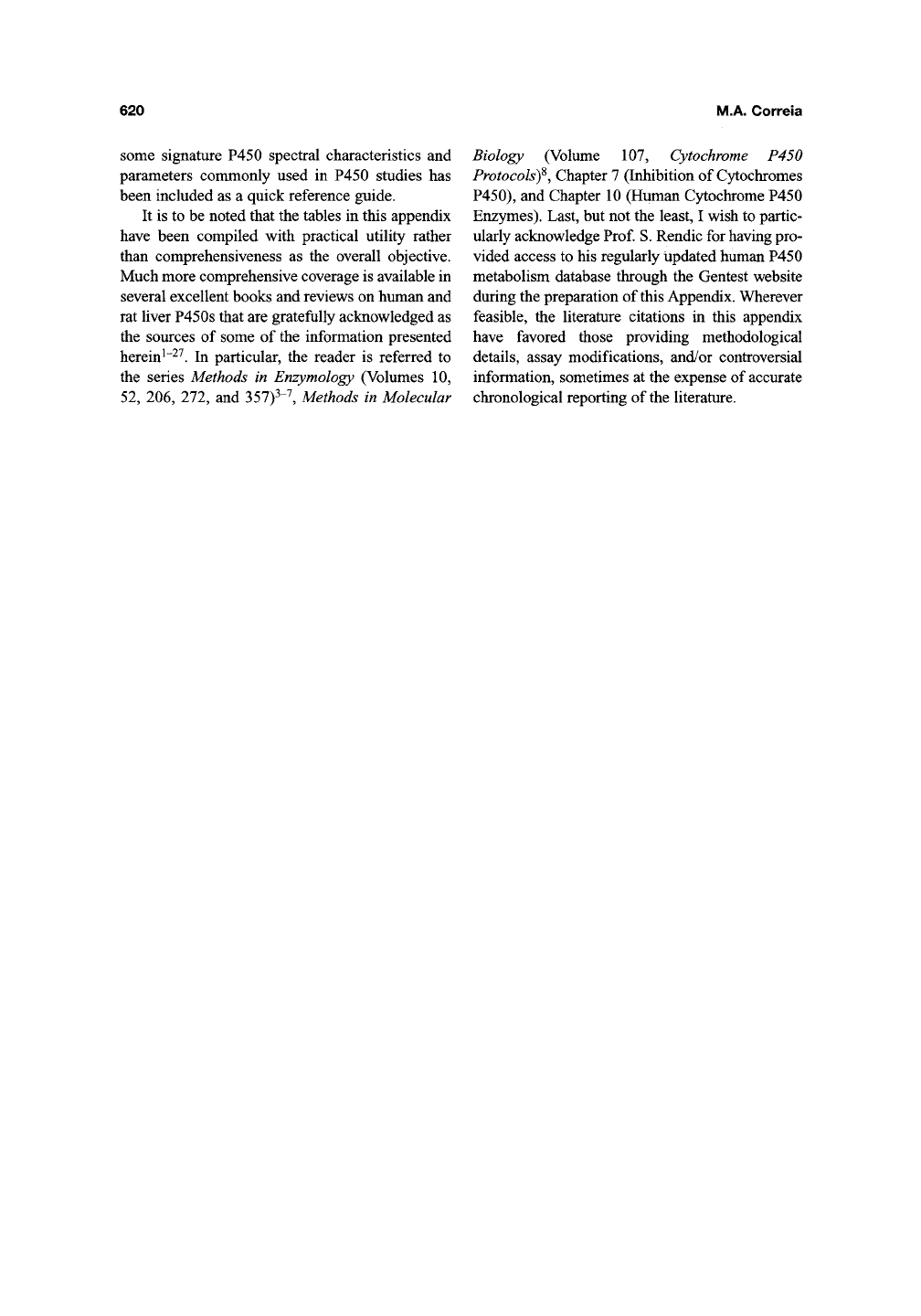
620
M.A. Correia
some signature P450 spectral characteristics and
parameters commonly used in P450 studies has
been included as a quick reference guide.
It is to be noted that the tables in this appendix
have been compiled with practical utility rather
than comprehensiveness as the overall objective.
Much more comprehensive coverage is available in
several excellent books and reviews on human and
rat liver P450s that are gratefully acknowledged as
the sources of some of the information presented
herein^"^^. In particular, the reader is referred to
the series Methods in Enzymology (Volumes 10,
52,
206, 272, and
357)3-^,
Methods in Molecular
Biology (Volume 107, Cytochrome P450
Protocols)^,
Chapter 7 (Inhibition of Cytochromes
P450),
and Chapter 10 (Human Cytochrome P450
Ervz^mQs).
Last, but not the least, I wish to partic-
ularly acknowledge Prof S. Rendic for having pro-
vided access to his regularly tipdated human P450
metabolism database through the Gentest website
during the preparation of this Appendix. Wherever
feasible, the literature citations in this appendix
have favored those providing methodological
details, assay modifications, and/or controversial
information, sometimes at the expense of accurate
chronological reporting of
the
literature.
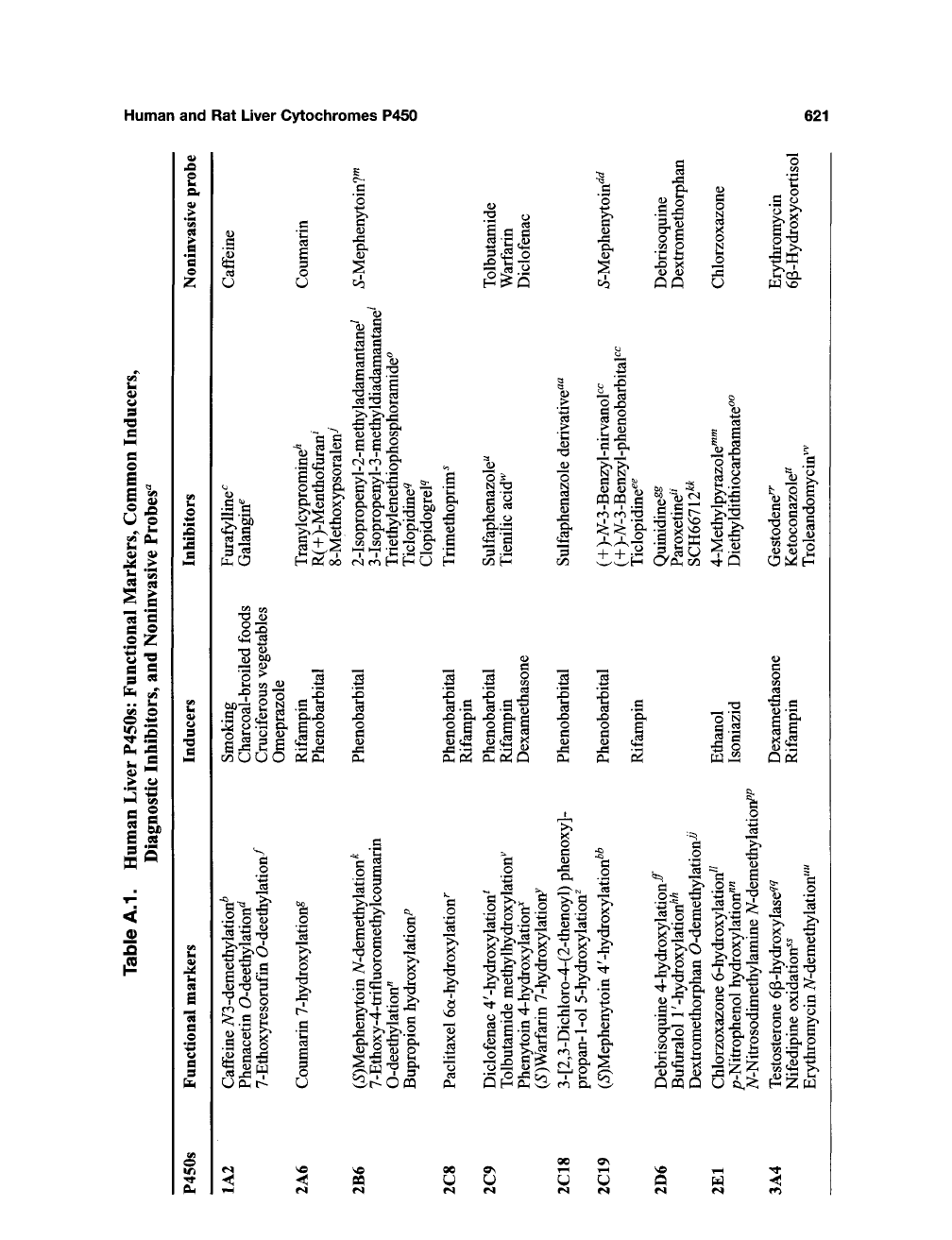
Human and Rat Liver Cytochromes P450
621
u
^
^
^
"O
fl
^^
c
o
s
S
o
c>
^
u
A
%
ci
fl
o
fi
P
EaM
,a
W
o
K)
-^
o
u
PM
^
.^
*wa
^
1
s
O
iz;
T3
fl
A
^
b
O
'^
2
OH
PA
^
9
>-
'2
a
0
fl
o
TJ
w
o
a
Q
<
J)
13
2
I
Co
f2iS
1
S"
a
s
PH
"s
'5b
03
'5
o
s +
s
&>§>•§»&
Hill,
&
11
o
5^
cS
I
^ o
cN
CO
H H U H
GO
H
I
^3
I.S
^ OH
O SH
£2
CD
III
I
^2 5 ^
gag ^
^
g
*o
1^
<u
^
OH
0?
S
c^
45
.. &
2^
o
t/) O
•C is
QQ
i
o
u
>
1
•S
3
1^
O 4D
e OH
1 1
PQPQ
en en
3
H
§2
"b
III
O^PLHC/3
o
2^
O
to
O
^
C3
ii
il
s S
a
o
r
.S
q::
«
5
<D 2 0) O
r
^
PLH
2 ^^a .§
•§lfe
<s
^
1-H
vo
<
n
vo
n
rl
00
U
fS
o^
U
fs
^H
u
fs
^^
u
fs
vo
Q
<s
M
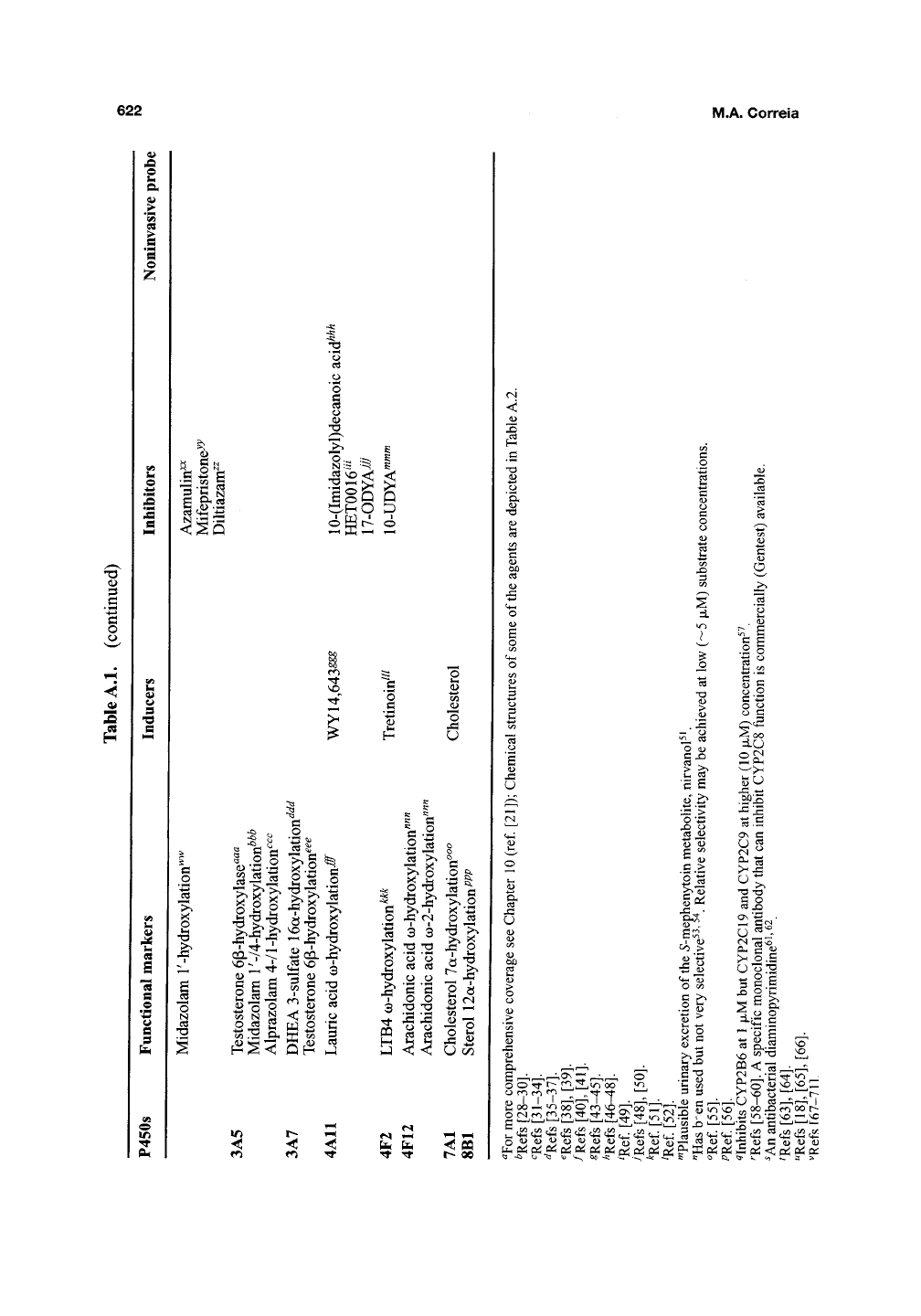
622
M.A. Correia
©
o
i
c o w w
S o Q Q
• [X] ' I
^3
I
o
o
I
4^
-«
fl
3
O
U
I
o
1 "
_o o ^_^
8 Is
It
II
2^
I/)
CM
in
<
m
r--
<U
m
TH
^
TT Si
< PQ
2
ts
^
3
V5
^-v
^
±
to
^
^
o
c
<u
O
-^
.2
. W
.2 o
ts ^
•s g
11
CO >
£^1
iiij
00
o m ^
SlIJlH
i
Si
I
til
PQ
(N
PH
^1
lIlJI
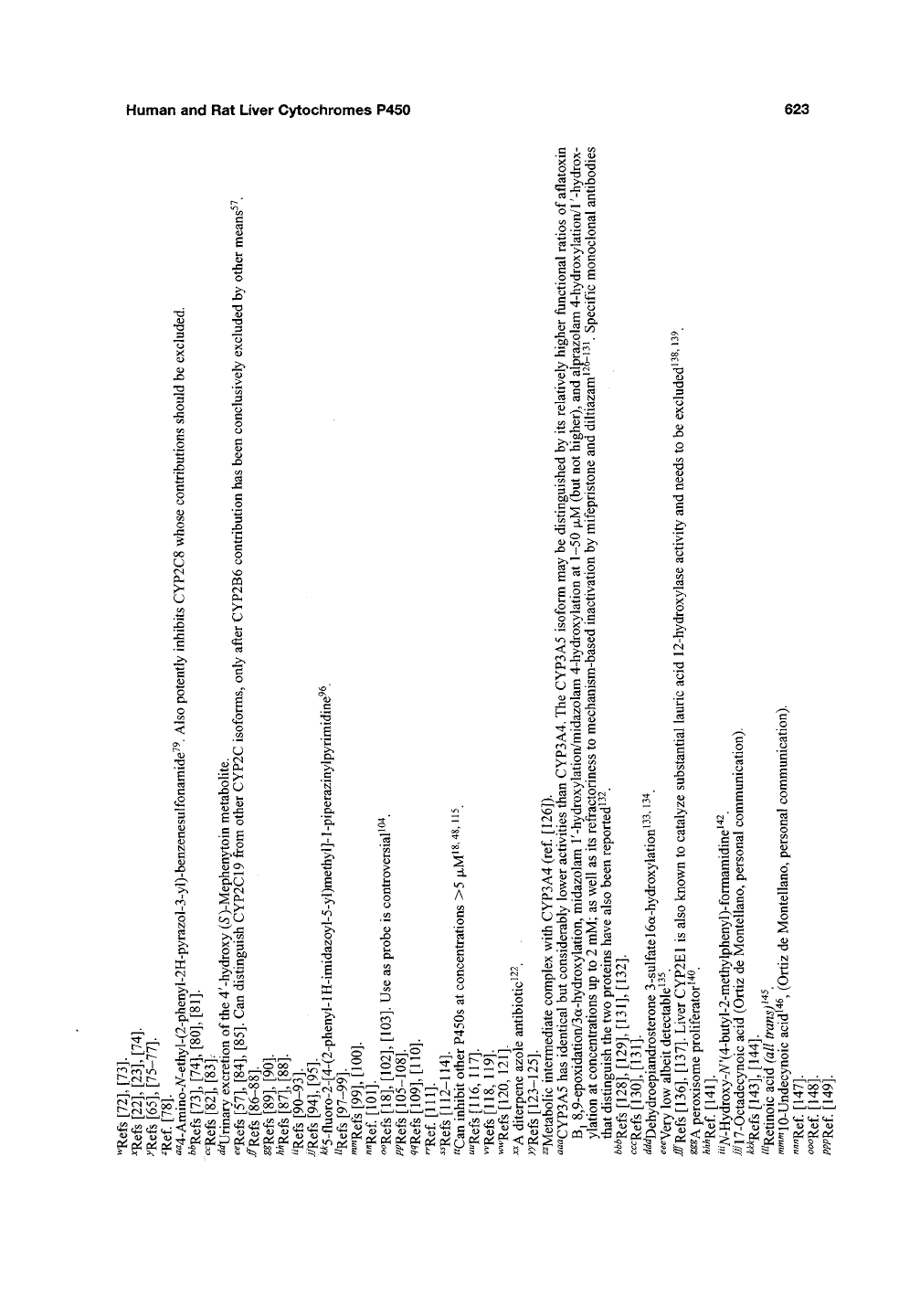
Human and Rat Liver Cytochromes P450
623
o
»^
>^
o
ed o O
-S.
o .
OH
•S
B
D ON
^
,—^
O
lo
r- a —"—'
03'—"—i"-
rr^^ eg c^ .g .£2 ^ ci
a.
is
72 g
O
3
JIJCN
^ r
.1 ^
;i
2LVON
. .^-'
^g^
3;-5^2::
•-^ fl
oo
<
>"-'
OJ
^'^
^'^ ^^ ^^
-i-"^(-(M-Hj<
fli qi nj fli
o c I
i5i5§^|
lis
1^^
S s=
5
•2II
•-^ O T3
<:|.^
^
J*-
^
o £.§
;^'5 2 o2
, . > ^ «3 ex
^ OTS ^ O
gj S.2 c^ o^
O cp Os^ § -^ ^.
"S P^ OO -^ ^ t^
.^
u
m
^^
p^
o
c
T3
I
p
a
^
o ^
3 . CM .
«2
"flj "o
-5
^
W N
?'^
(N
O
-O
c3
^
•-d
o
•o'
""^
^^
13
.1^
P^Cci
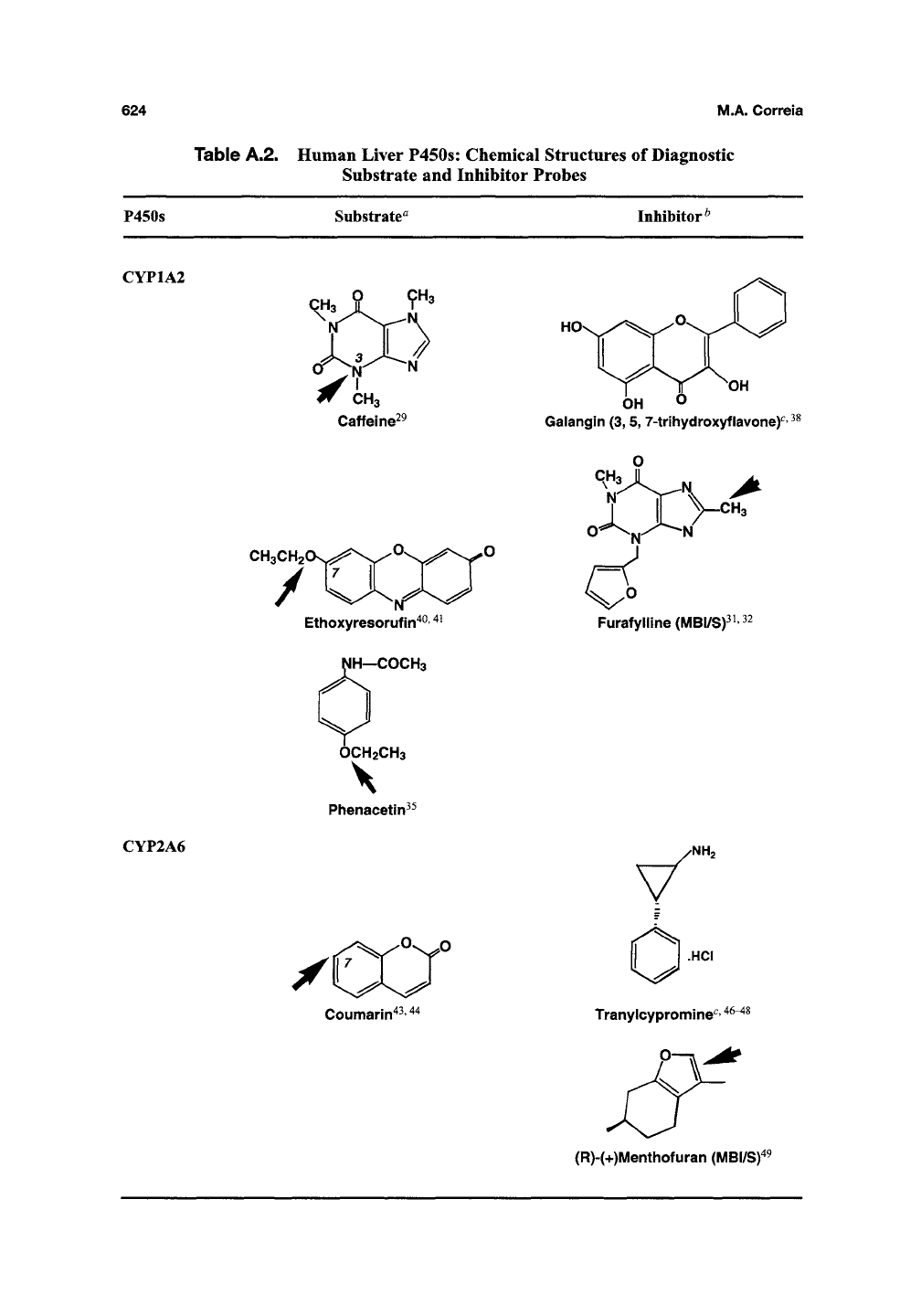
624 M.A. Correia
Table A.2. Human Liver P450s: Chemical Structures of Diagnostic
Substrate and Inhibitor Probes
P450S
Substrate^ Inhibitor^
CYP1A2
CYP2A6
CH3CH2'
Ethoxyresorufin^o^^
^H—COCH3
o^^o
Coumarin'^
OH O
Galangin (3, 5,7-trihydroxyflavone)^ ^^
Furafylline (MBI/S)3^ ^2
NH.
.HCl
Tranylcypromine'^'
'*^^^
(R)-(+)Menthofuran (MBI/S)"^
x)^
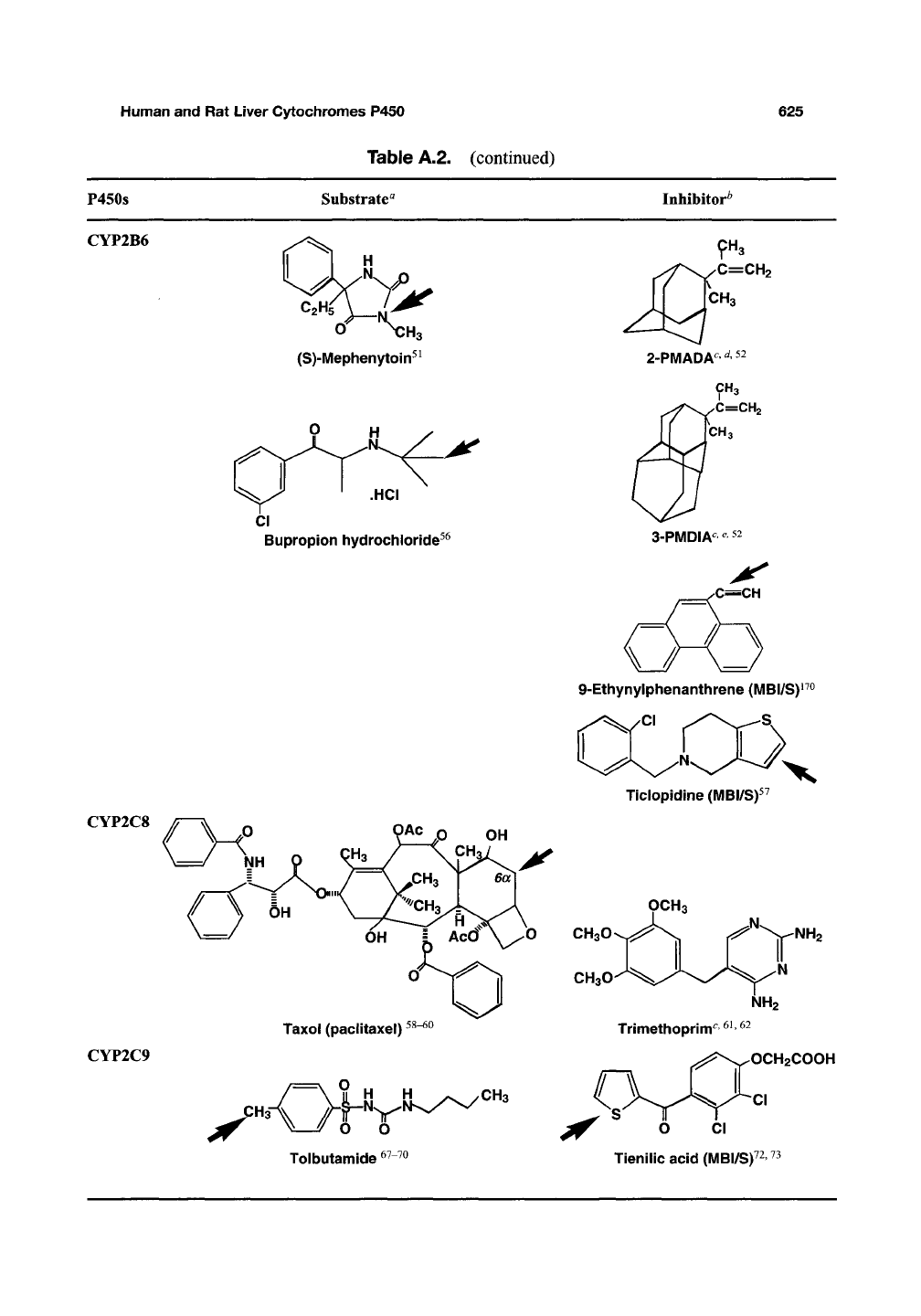
Human and
Rat
Liver Cytochromes P450
Table A.2. (continued)
625
P450s
Substrate^
Inhibitor^
CYP2B6
O'
XH3
(S)-Mephenytoin^^
2-PMADA^'^52
Bupropion hydrochloride^'
3-PIVIDIA^
9-Ethynylphenanthrene (MBI/S)^^^
/CI ,x^^\^Sv
'
J.
Ticlopidine (MBI/S)'
CYP2C8
\==/
NH
^^^
JD OH
CH
CYP2C9
Taxol (paclitaxel) ^^^^
^"•-v/fv^^
Tolbutamide
^
O
CI
Tienilicacid(MBI/Sp,73
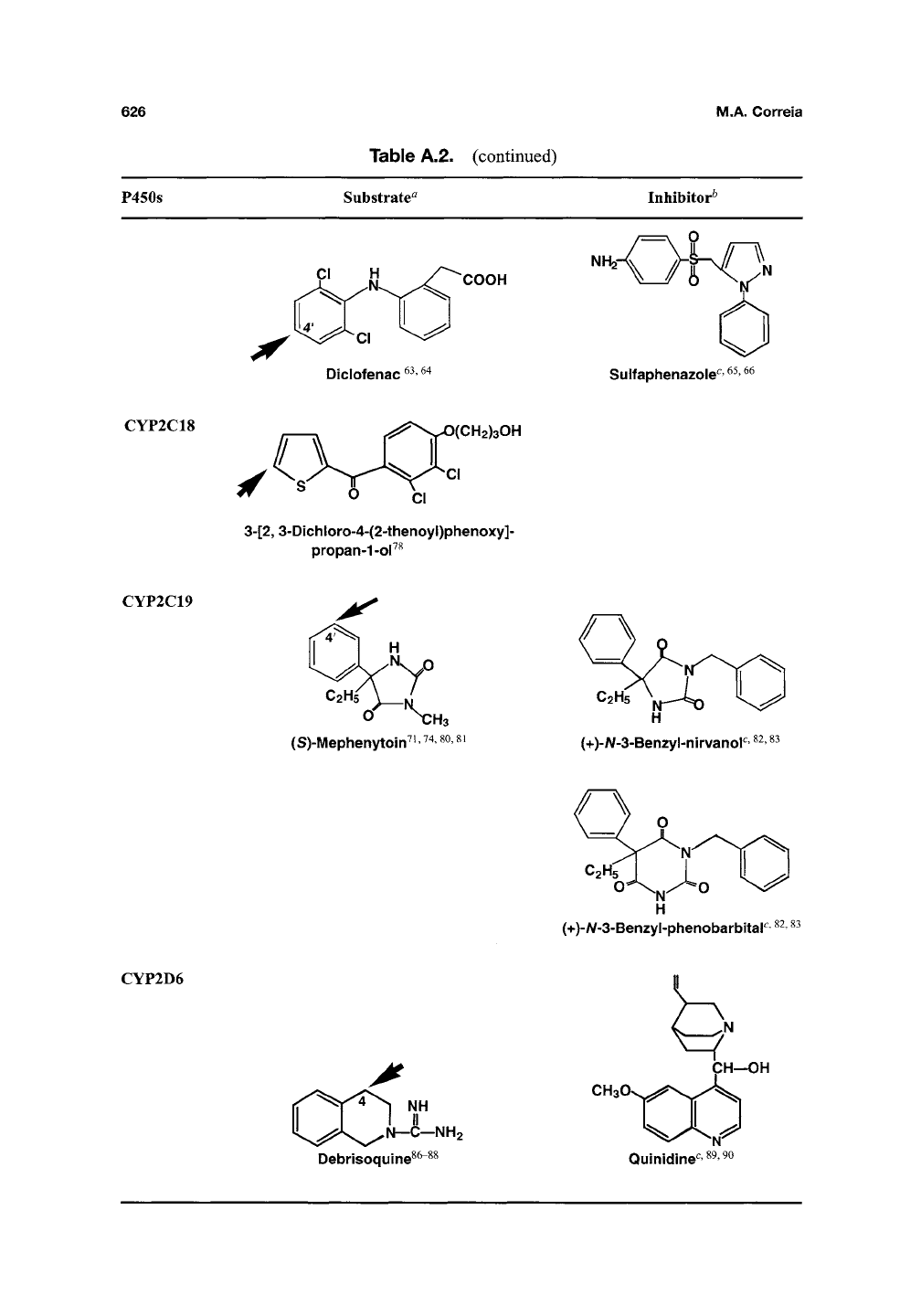
626 M.A. Correia
Table A.2. (continued)
P450s
Substrate^
Inhibitor^
Diclofenac
^^
^"^
COOH
'^-vjhQ"
Sulfaphenazole^
CYP2C18
3-[2, 3-Dichloro-4-(2-thenoyl)phenoxy]-
propan-1-or^
CYP2C19
(S)-Mephenytoin7i^4,8o^i
(+)-A/-3-Benzyl-nirvanol'^'
(+)-A/-3-Benzyl-phenobarbital^
CYP2D6
4
> NH
.
II
N—C—NH2
Debrlsoqulne^^^^
Quinidlne^^9,9o
